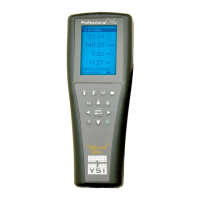12. If you receive a warning message stating that the calibration is questionable, do not
continue with the
calibration. Instead, select ‘No’ and investigate what is causing the questionable results. If you accept a
questionable calibration, your ammonium and ammonia readings will be erroneous. Typical causes for this
error message include: incorrect Sensor/Port setup in the instrument, a dirty sensor or bad buffer solution.
Preparing Ammonium Calibration solution
We recommend using YSI calibration solutions whenever possible. However, qualified users can save cost by
following these recipes for 1 and 100 mg/L standards. Other concentrations can be made by altering the amount
of ammonium chloride. All other ingredient concentrations should remain unchanged. It is important to note that
some of these chemicals are hazardous and therefore, the standards should only be prepared by qualified
chemists in laboratories where proper safety precautions are possible. It is the responsibility of the user to obtain
and study the MSDS for each chemical and to follow the required instructions with regard to handling and
disposal of these materials.
You will need: solid Ammonium Chloride or a certified 100 mg/L NH
4
+
-N from a supplier, Lithium Acetate
Dihydrate, concentrated hydrochloric acid, high purity water, a good quality analytical balance, a 1000 ml
volumetric flask, accurate volumetric measuring devices for 100 ml and 10 ml of solution, and a 1000 ml glass or
plastic storage vessels.
(Caution: Hydrochloric acid is highly corrosive and toxic and should therefore be
handled with extreme care in a well-ventilated fume hood. The user could also add the equivalent amount
of a less-hazardous, more dilute sample of the acid if preferred.)
100 mg/L Standard
: Accurately weigh 0.3817 g of ammonium chloride and transfer quantitatively into a 1000 ml
volumetric flask. Add 2.6 g of lithium acetate dihydrate to the flask. Add approximately 500 ml of distilled or
deionized water to the flask, swirl to dissolve all of the reagents and then dilute to the volumetric mark with
distilled or deionized water. Mix well by repeated inversion and then transfer the 100 mg/L standard to a storage
bottle. Add 3 drops of concentrated hydrochloric acid to the bottle, then seal and agitate to assure homogeneity.
Alternatively, 100 ml of certified 100 mg/L NH
4
+
-N standard can be used in place of the solid ammonium chloride.
1 mg/L Standard
: Accurately measure 10.0 ml of the above 100 mg/L standard solution into a 1000 ml
volumetric flask. Add 2.6 g of lithium acetate dihydrate to the flask. Add approximately 500 ml of distilled or
deionized water, swirl to dissolve the solid reagents and then dilute to the volumetric mark with water. Mix well by
repeated inversion and then transfer the 1 mg/L standard to a storage bottle. Add 3 drops of concentrated
hydrochloric acid to the bottle, then seal and agitate to assure homogeneity.
TROUBLESHOOTING TIPS
Typical working life for ammonium sensors is approximately 3-6 months depending on use, storage and
maintenance. Proper storage and maintenance generally extends the sensor’s working life.
If you get error messages during an ammonium calibration, check the following:
1. Ensure the ammonium solutions are good and not expired
2. Ensure that the ammonium sensor is installed in the correct port of the cable and the correct ISE is enabled
in the Sensor Setup menu.
a. If using an ammonium sensor in a 6051020 cable, ensure the sensor is installed in port 1.
b. If using an ammonium sensor in a 60510, 6051020 or 6051030 cable, ammonium should be enabled
in ISE1 in the instrument’s Sensor Setup menu.
c. If using an ammonium sensor in a 6051010 or Quatro cable, check to see if the ammonium sensor is
installed in the port 1 or port 2. If the ammonium sensor is installed in port 1, enable ammonium in
ISE1 of the Sensor Setup menu. If the ammonium sensor is installed in port 2, enable ammonium in
ISE2 of the Sensor Setup menu. Note: If using with a pH or ORP sensor, it is recommended to
install the pH or ORP sensor in port 1 and the ammonium sensor in port 2.
16

